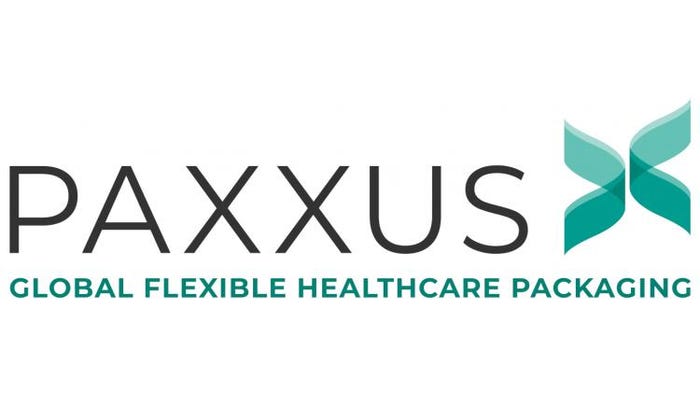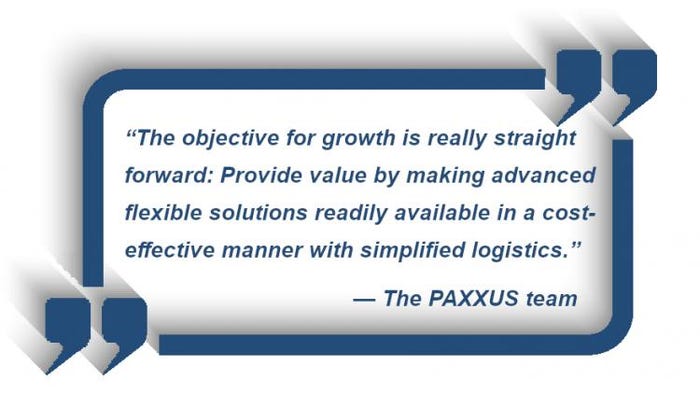Flexible packaging innovator Rollprint Packaging Products, in business since 1933, has merged with Alliantz Flexible Packaging in Singapore and EuroFoil Teo in Ireland. PAXXUS—the combined company’s new global identity—is now positioned as a leading international supplier of flexible packaging for the healthcare market.
The strictly regulated medical market, while highly attentive to change, welcomes improvements and innovations in packaging materials. So what do medical device manufacturers need to know about the new PAXXUS? Packaging Digest asks the PAXXUS team about the merger, the company’s structure and new capabilities, growth plans and more.

From left to right: Ciaran Foley, managing director, PAXXUS Europe; Noel Foley, director, PAXXUS Europe; Dwane Hahn, chief strategy officer, vp of sales and marketing; Dhuanne Dodrill, chief executive officer (CEO); Doug Dodrill, chief technology officer; Eddy Chan, managing director, PAXXUS Asia; and Xinyi Chan, business development manager, PAXXUS Asia.
PAXXUS is derived from the Latin word for peace, pax, meaning the company strives to provide customers peace of mind. How did you come up with the name PAXXUS? Why is peace of mind so important to manufacturers of medical devices, pharmaceuticals and life sciences products?
PAXXUS team: Selecting a company name when serving the global market was challenging. We looked for one that would be seen positively across the many cultures and languages with which we work. Turning to Latin, we found the word ‘pax’, meaning peace. Because our products impact all of “us,” we decided PAXXUS was a fitting name.
In line with our mission to improve quality of life through engineered flexible materials, we embrace the view that our product is more than just a package. PAXXUS touches more than two billion patient lives across the globe every year. Positive outcomes for these patients depend upon the reliable supply and consistent quality of our materials. The materials that we produce ensures the sterility and efficacy of the end product, aids in its identification and allows effective delivery into the sterile field or to the end-user. Our goal is to provide peace of mind, not only to our customers, but ultimately to the patients that, together, we serve.
Who owns PAXXUS?
PAXXUS team: PAXXUS is still a closely-held private company owned entirely by the three original families: the Dodrills, Chans and Foleys. Most decisions are made at the local level with only significant decisions (such as large capital expenditures) made at the Board level. The Board is comprised of members of the three families, with Dhuanne Dodrill holding the position of chairman.
One of the benefits of PAXXUS remaining privately owned is the company can invest for the long term and keep a singular focus on innovation in healthcare packaging for the ultimate benefit of customers. Are there other advantages?
PAXXUS team: Packaging innovation and adoption in healthcare is widely regarded as a slow process due to the complex regulatory requirements. Challenges in proving shelf-life claims and extensive validation protocols frequently require project plans that take upwards of three years. A crucial benefit of PAXXUS remaining a closely-held private company is that we can invest for the long term and keep a singular focus on innovation in healthcare packaging for the benefit of customers. Ultimately, this allows for long-term partnerships to form, which allow for the collaboration required for innovation to mature and move to commercial success.
As family owned, closely-held companies, Rollprint, Alliantz, and EuroFoil were each nimble and responsive. As we merged, we’ve purposely structured PAXXUS so that we have an efficient decision-making process. With the original three families still in control and no outside investors, we’ve maintained our independent and entrepreneurial spirit.
Rollprint and Alliantz have been sister companies for 15 years, supporting and complementing each other. And Rollprint has been working with EuroFoil Teo for the last four years. What are the added capabilities of the now-merged trio?
PAXXUS team: Globally, we have a wealth of knowledge and experience—from technology, to systems, to engineering, to market insight. It’s been exciting and rewarding to see how the strengths of the different locations have complemented each other and have strengthened PAXXUS.
Together, PAXXUS has the capabilities, across multiple locations, to manufacture the range of flexible packaging materials needed to supply the healthcare industry. We manufacture base films; we create multi-layer composites via blown film extrusion, adhesive lamination, solution coating and extrusion lamination/coating; we convert pre-formed pouches and bags; and we print all of these materials.

How does being vertically integrated benefit customers?
PAXXUS team: PAXXUS is one of the few companies focused on the life sciences sector that can manufacture its own materials. Our clients are not limited to choosing from a catalog of “stock products.” Beginning with the resin and base component selection, we are able to design our structures to meet a customers’ particular needs and requirements while optimizing cost effectiveness.
However, for small-volume applications, we do stock a standard array of our most popular technologies. By being primary in the manufacturing and not relying solely on outside vendors, our customers benefit from improved quality, pricing and delivery.
The three companies that merged are strategically located in the U.S. (near Chicago), Ireland (the Silicon Valley of the European healthcare industry) and Singapore (the hub of southeast Asia). How will this global footprint benefit small local customers as well as multinationals?
PAXXUS team: Regional customers will have expanded access to the full range of technology and products we offer, global technical support, potentially shorter lead times and a local point of contact. Multinational accounts benefit from improved business continuity, multiple sources of supply allowing for reduced lead times, and the plants can have local support worldwide.
What are some key differences in market trends in the different regions (U.S., Europe and Asia) and how will the new company be better positioned to address these trends?
PAXXUS team: When it comes to sustainability, the regions are at different places in their journey, with Europe leading the charge. PAXXUS offers excellent recyclable/recycle-ready single-stream materials with various sealant and barrier technology options.
Across all regions we see a desire for short, high-mix print runs to accommodate the language and identification requirements of different countries. For example, we have a large account that manufactures in Ireland that is already benefiting from the merger. By moving the printing and laser-scoring of their many stock-keeping units (SKUs) from the U.S. to Ireland, they’ve seen a significant reduction in lead time. This allows them to more quickly react to changes in demand and to substantially reduce their inventory.
Additionally, we are seeing much more interest in new sterilization technologies (such as alternatives to ethylene oxide or EO) that may be more cost effective and offer logistical advantages. Regardless of which sterilization method is preferred, PAXXUS can provide solutions.
The company is investing U.S.$15 million across all locations. What are you using that money for specifically and why that?
PAXXUS team: The investments we are making will help us accomplish three things:
1. Expand our offerings and support;
2. Add manufacturing redundancies; and
3. Increase capacity.
The seven-layer blown film line we are installing in Singapore will allow us to provide nylon-based thermoformable form-fill-seal materials for applications that require improved puncture resistance.
The laser-scribing equipment we just commissioned enhances tear and opening properties but also opens up the possibility of additional innovations in healthcare packaging.
The laminating equipment we are adding to our Ireland operation provides manufacturing redundancy, as well as local supply for our European customers.
We are expanding technical centers with added testing capabilities and local support for our offerings.
To support our growth, we are also adding additional manufacturing capacity.
What are the combined-company’s growth plans? Will the company remain solely focused on flexible healthcare packaging solutions?
PAXXUS team: Combining the strengths of the three original companies, PAXXUS is able to serve the range of healthcare packaging needs—from the most complex, highly-engineered solutions to less-demanding applications.
Even while others are deemphasizing healthcare packaging, we believe that focusing on healthcare makes sense for the new entity and that strong growth will continue for many years to come. As we continue our mission to serve the broader healthcare market, PAXXUS will look to add manufacturing with state-of-the-art assets closer to customers.
The objective for growth is really straight forward: Provide value by making advanced flexible solutions readily available in a cost-effective manner with simplified logistics.

Can you give an example of how the new company structure has been a seamless change for customers?
PAXXUS team: As we want this transition to be seamless for customers, we are managing every detail of the process through the eyes of our customer. We have been able to take a step back and deliberately employ and standardize on the best practices from each location. Our primary goal as a global organization is to provide the expected reliable, agile service—now exceedingly accessible around the world.
How is the process of harmonizing the three different systems going?
PAXXUS team: Historically, all three of the original entities served the highly regulated healthcare industry and have partnered in serving shared customers. We have found that we are already highly harmonized, making the transition simple and painless.
How will the company develop new products differently moving forward to take advantage of its added capabilities?
PAXXUS team: There are several opportunities and development tools that are enhanced by the combined operations.
One of the most critical of these is the ability to better design and control the point of differentiation for our products. We optimize the economies of scale by producing the base materials and multilayer precursors in the optimized facility; ultimately achieving a reduction in lead time and transportation costs. All while customizing and finishing the product in the location closest to the end user.
Second, the combined experience and capabilities of technical experts around the world are being consolidated into one shared knowledge database. Best-in-class statistical design techniques are being expanded to all sites so that the product development process is both efficient and data driven. Expertise in the unique product and regulatory requirements for each region have now been brought together under the PAXXUS umbrella.
New developments are now evaluated with a worldwide lens. Candidate materials are identified and sourced in the context of global supply to ensure that business continuity is assured after the design has been completed, validated and released for production.
Any new product launches scheduled for WestPack 2019?
PAXXUS team: We’re excited to introduce our forming webs that have been engineered to pair with uncoated 40L Tyvek. This year, we are also going to use WestPack as an opportunity to showcase our existing innovations that are hyper-relevant to current packaging trends. Primarily, we are highlighting StreamOne, our recycle-ready lidding.
Additionally, we would like to continue to spread the word about PAXXUS’ global expansion and our standing commitment to improving the quality of life through engineered flexible materials.
About the Author(s)
You May Also Like




